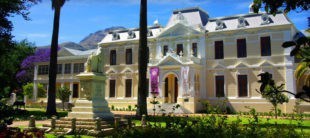South African wine is just another piece of the South African puzzle.
In the view of most Europeans who visit South Africa the very first time, its extremes – i.e. luxury hotels, town ships, beautiful beaches and national parks – are overwhelming. But wine connoisseurs are also pleasantly surprised, South Africa it turns out, is a paradise for the oenophiles. Typical South African wines are low in tartness and emit delightful fragrance. The climate in the country is mostly smooth and moderate all year round. In short, conditions are very favorable to the cultivation of vine grapes and the wine routes in the Western Cape province is one of the most popular attractions of the visitors. The “wine routes” involves visiting South Africa’s wine-producing towns of Stellenbosch, Paarl, Franschhoek and Constantia. Note: In all provinces are more than four thousand farms engaged in the cultivation of grapes and wine production.
Local wine making tradition goes back 350 years, to the first Dutch settlers. In 1659 the first real drinking of Cape wine was inaugurated. Somewhat later, during the religious wars, when France became unsafe for the Huguenots, two hundred refugees after many wanderings, found themselves in the South African coast – apart from the sad memories of the homeland, they brought with them the secrets of French winegrowers.
The Cape Winelands
Wine lover or not, a visit to the Cape Winelands is an absolute must as the region is one of breathtaking vistas and majestic mountain backdrops while being steeped in rich culture and history. Rolling vineyards and quaint Cape Dutch homesteads await you, as well as award-wining wine farms offering some of the best South African wines. The Winelands are divided into various different regions, each offering their own ‘wine route’. The most popular and well-known are Stellenbosch, Franschhoek, Wellington and Paarl. Stellenbosch. The wine farms of Stellenbosch are the closest in distance to Cape Town and are within a 45-minute drive of the city centre. This is the most well known wine region and is home to a variety of cellars-producing some of the country’s most acclaimed wines.
The city of Stellenbosch is a historically important university town and the oak-lined Dorpstraat with its original, deep storm water drains is home to museums and galleries, as well as many student cafes and restaurants.
Franschhoek and Huguenot Memorial
The theme of the Huguenot Memorial Museum in Franschhoek is the history of the French Huguenots before and after their arrival at the Cape of Good Hope. The French Huguenots were a group of people who fled France in the 1660s due to religious conflicts. After Martin Luther published his 95 theses against the corruption of the Roman Catholic Church in 1517, many people felt that what Luther had said was true and he soon had a large following who became known as Protestants. Within 20 years, large groups of protestants could be found in Switzerland, France, the Netherlands and Scotland and it was the people who later became known as Huguenots. As The Catholic Church was the only official Christian church in Europe at that time, the Huguenots were in a constant state of persecution and fled there homelands. Some of those who fled to the Netherlands ended up setting sail for the Cape of Good Hope in South Africa.


